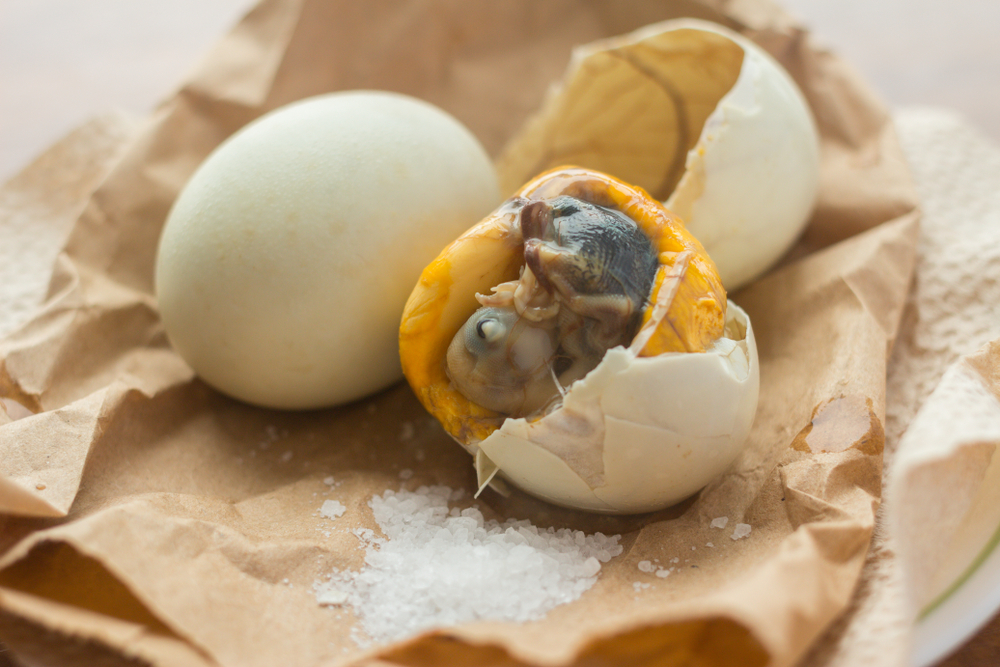
Balut is one aspect of a vibrant array of food eaten in the Philippines. Across the countries seven thousand islands, you will find local communities, all with their own unique delicacies. You will regularly find people enjoying sea urchin, worms, and chicken organs. This style of food can be purchased from street food vendors, and markets found across the country.
Within this street food scene, is where you will find Balut. It is often spoken about as a delicacy, though in modern day Philippines, it belongs more in the street food category. Delicacy implies luxury food items like truffles or caviar. Though it once could have been in that category, you will now find Balut being sold in places like the streets of Manila. The locals love the egg to be nice and hot, and love to wash it down with a cold beer.
So, let’s continue to see what this famous Filipino dish actually is.
So, what exactly is Balut?
Balut is a chicken or duck egg which is boiled or steamed. You then crack open the top of the shell, then pour some salt and vinegar to the top, some people add other toppings like chilli sauce to the egg.
Now, what makes Balut interesting is the egg is fertilised. The embryo is left to grow in the egg for around sixteen to twenty-one days. The egg is then cooked and served to customers with not only the yolk present inside, but also the embryo.
I know it doesn’t sound alluring, eating a half developed embryo isn’t everyone’s idea of a delicious snack. A lot of foreign tourists are put off by the sight of the egg. But many people do try it when they visit the country.
Most “first timers” will opt for an egg that is around the 16-week mark, as the embryo is less developed, the appearance is a little less intimidating. Although it looks off-putting, the taste of the hot egg with the salt and vinegar is actually quite nice.
Besides the large amounts of salt added to the egg, the dish isn’t completely bad for you. It contains all the usual health benefits from egg, as well as being rich in vitamin C, protein, calcium, and beta-carotene.
Where did Balut originate?
Balut began to emerge in the Philippines starting in the 16th century. The Chinese population in the country were primarily responsible for the adoption of the food in the Philippines. Before refrigerators were created, the Chinese use the fertilised duck eggs as a means of extending the shelf life of the eggs.
The global influence that comes with high levels of migration from south-east Asian nations can also not be ignored. The initial spread of Balut came from Chinese migration to nations such as the Philippines, Vietnam, and Thailand. Now with high levels of migration into western nations, you can now easily find Balut almost anywhere. It’s as easy as paying a visit to your local Asian supermarket.
Balut holds a particular cultural importance in Philippine history, now reaching the position of being the countries “national street food”. This demand for these fertilised eggs has helped strengthen the farming industry in the country. Ducks have become one of the most profitable livestock in the farming industry.
A lot of sociocultural factors dominate Balut market. These factors are different from the nutritional values. as it is a good source of protein and calcium. But that is not the primary reason why it is loved by Filipinos.
The home to this vibrant industry at one point was found in the nation’s capital of Manila. More particularly Pateros, a municipality within Manila.
Pateros held an estimated 400,000ducks, meaning this was the primary source of income for the residents in the area. During the 50s and 60s, this region was teaming with life due to the duck industry. The local makers had developed their own methods of creating Balut, and salted egg. This started from the careful selection of the egg through to the incubation and cooking process.
Unfortunately, this did not last. With the increasing pollution of Metro Manila came the downfall of the local duck industry. Through the 70s the industry began to move out to more environmentally friendly regions like Laguna.
Click here to read more about exciting Filipino cuisine.

What is involved in preparing Balut?
Balut is prepared in a cautious and controlled manner. The technique used will determine whether or not you get the best flavours. All the techniques used have been traditionally learned by the local makers.
The fertilised eggs are first taken and incubated under the heat of the sun, or they may be buried in layers of sand. Then they are placed in bamboo baskets to sustain the warmth to help preserve the egg. After a period of nine days, the eggs are finally revealed to a light source to see the embryo inside.
The various stages of maturation of the egg and different controlled temperatures play a significant role to accentuate all the characteristics a good egg would have. The egg changes colour during the maturation period also.
Now, you may be wondering when is the egg ready to eat?
Well, the time of incubation of the egg before they are boiled depends on the locals, which vary from 14 to 18 days. After cooking, the eggshell is cracked open, this is were you will familiarise yourself with the primary parts of the dish.
First you’ll notice a mix of the embryo and the egg yolk peering through the crack in the shell,if you then tip the egg, you’ll find the broth inside that everyone loves to drink. Then at the end you’ll find the hard rubbery part known as the rock. The whole process of making and consuming Balut is in itself an experience.
So when visiting the Philippines, it will be hard to avoid trying Balut. You can find it everywhere these days. Most of it you will find is the mass-produced style, these are made at large commercial farms where the ducks receive a generic feed.
Some of the exotic restaurants which cater to tourists have their own version of the Balut where it is had with a lot of spices and salts. This Balut is often sourced from more boutique farms, where they pay special attention to the kind of food they give their ducks to ensure they achieve the highest quality egg.
So, as you can see, the simple act of enjoying Balut is a means to immerse yourself in the local culture of the Filipinos and have a first-hand experience of their traditions.
The preparation techniques of Balut have evolved in modern day life, and I’m sure will continue to develop into the future. This makes Balut one of Philippine’s widely sought after dish; now you can try one too.
Click here to learn more about the vibrant culture of the Philippines!





Thanks for the excellent manual
If there is one popular street food you should try in the Philippines then it should be no other than the universally famous balut. To many, it takes quite a lot of nerve to take a bite out of this exotic food ubiquitously found all over the Philippines.